Birdfinding.info ⇒ The winter-breeding North Atlantic form of Band-rumped Storm-Petrel is the most numerous and widespread of the three near-identical forms that overlap widely on their Macaronesian breeding grounds (the other two are Monteiro’s and “Madeiran”). From August to April, “Grant’s” can be found in the waters around the Azores, Madeira, and Canary Islands. From May to August, it is fairly common in Gulf Stream waters of the eastern U.S. and in the Gulf of Mexico, and is often seen on pelagic trips out of ports such as Hatteras, Cape Canaveral, and Port Aransas.
“Grant’s Storm-Petrel”
Hydrobates castro ssp. nova
Breeds in Macaronesia; disperses across the subtropical North Atlantic.
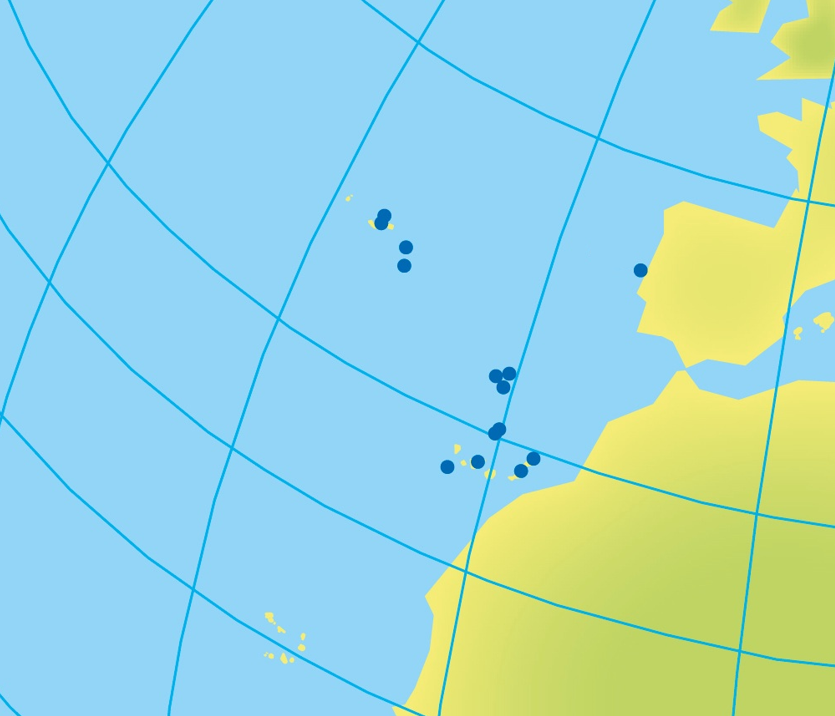
Approximate locations of “Grant’s Storm-Petrel” breeding colonies. © The Sound Approach 2019
Breeding. Breeds in fall and winter on several island groups of the eastern North Atlantic: the Azores, Madeira, Selvagens, Canaries, and Berlengas (adjacent to central Portugal).
The breeding season is approximately August to April. Adults return in August and September and lay their eggs from October to early December. Juveniles fledge from February to April.
Nonbreeding. Although incompletely known, the available evidence indicates that a large portion of the population—perhaps the majority—migrates west during April and May to spend the summer months in the Gulf of Mexico and Gulf Stream waters east of North America, where they molt and recover their strength, then depart around August.
The multiple forms or species traditionally classified as the Band-rumped Storm-Petrel are nearly identical and therefore difficult to identify definitively away from their breeding grounds. Band-rumped-type storm-petrels have long been known to occur in U.S. waters in summer, and most of these individuals appear more consistent with “Grant’s” than the other forms. In particular, a large proportion show either heavy feather-wear or molting flight feathers, or both, which indicate that they are likely post-breeding adults, and the timing of their presence generally corresponds to the nonbreeding season for “Grant’s”. This theory has been corroborated by a band recovery: an individual banded on Ilhéu de Praia in the Azores, on September 25, 1993, was caught by a fisherman offshore from Pensacola, Florida, on April 27, 1998.
Identification
As a form or potentially cryptic species within the Band-rumped Storm-Petrel complex, “Grant’s” is visually indistinguishable from other band-rumped-type storm-petrels under most circumstances—but it can sometimes be identified positively based on its molt-timing, which differs from that of other North Atlantic forms.
Its tail averages less notched, more square-tipped than on Monteiro’s—the other band-rumped-type storm-petrel that breeds in the Azores—but this feature varies and overlaps widely between them.

“Grant’s Storm-Petrel”, H. c. ssp. nova—likely this form, in fresh plumage to begin the breeding season, despite the apparent notch in the tail. (Banco de la Concepción, Canary Islands, Spain; September 2, 2017.) © Miguel Rouco
Like other band-rumped-type storm-petrels, “Grant’s” is dark-brown overall, with an even white band across the rump that usually extends partway down the sides of the rump to the undertail.

“Grant’s Storm-Petrel”, H. c. ssp. nova—likely this form, in fresh plumage to begin the breeding season—note the exceedingly narrow white rump-band, a feature that seems to be subject to individual variation, not diagnostic of any North Atlantic form in the Band-rumped complex. (Banco de la Concepción, Canary Islands, Spain; August 17, 2014.) © Miguel Rouco
As with most dark storm-petrels, all band-rumped-types typically show a paler brown or whitish diagonal stripe on the wing coverts, but the boldness varies depending on molt-stage and lighting. So the apparent color and boldness of the wingbar can provide clues to the age and molt-stage of closely observed individuals.
Juveniles and freshly molted adults have the most pronounced wingbars. On juveniles the bar appears white. On adults returning to the breeding grounds, the bar is blond. With feather-wear, the bar diminishes and can disappear entirely by the time the next molt begins.
For conditions where wing-molt can be discerned: adult “Grant’s” begins molting in winter and completes in summer (opposite of both Monteiro’s and “Madeiran”); and first-year “Grant’s” would likely begin molting in September and complete in April (see Howell & Zufelt 2021). Consequently, band-rumped-type storm-petrels observed in worn plumage and obvious molt during spring and summer in the North Atlantic, such as the one photographed below, are likely to be post-breeding adult “Grant’s”.
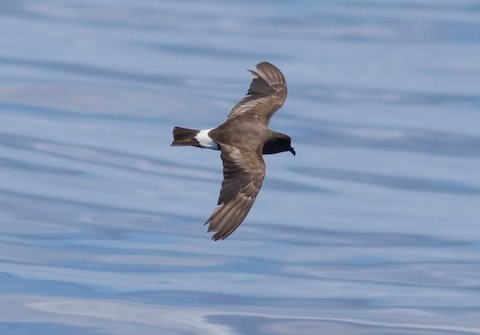
“Grant’s Storm-Petrel”, H. c. ssp. nova, in worn plumage, molting its flight feathers, a condition that is effectively diagnostic of “Grant’s” at this season. (Offshore from Cape Hatteras, North Carolina; June 1, 2015.) © Michael Todd

“Grant’s Storm-Petrel”, H. c. ssp. nova, in worn plumage, molting its flight feathers, a condition that is effectively diagnostic of “Grant’s” at this season. (Offshore from Cape Hatteras, North Carolina; June 1, 2015.) © Michael Todd
Voice. Two types of calls are heard at breeding colonies: chattering and purring. Both resemble the equivalent calls of other storm-petrels, but differ in their patterns.
“Grant’s’” chatter call has a consistent pattern that distinguishes it from the chatter calls of other North Atlantic band-rumped-types: it consists of about nine squeaky notes (like rapid rubbing of a fingertip on wet glass), ending with two pairs of louder, sharper squeaks: “Grant’s’” purring call consists of a purr that builds for about 1.5 seconds then ends with a flourish of squeaks, the last two louder and sharper (like the ending of the chatter call, but once instead of twice): (For a detailed review with more recordings and sonograms, see The Sound Approach: Grant’s Storm-Petrel.)
Notes
Monotypic form, one of seven or more potentially distinct forms of Band-rumped Storm-Petrel (castro), which is in the midst of taxonomic revisions. Eventually, it seems likely that the two North Atlantic forms, “Madeiran” (castro) and “Grant’s” (ssp. nova, presumptively to be named granti), will be classified separately from the South Atlantic and Pacific forms.
See below for comparisons of “Grant’s Storm-Petrel” with Monteiro’s Storm-Petrel and other Atlantic members of the Band-rumped Storm-Petrel complex.
Cf. Monteiro’s Storm-Petrel. Among the many populations of storm-petrels that were formerly classified together as Band-rumped, the first discovery of a “cryptic species” distinction was between the two populations that breed in the Azores: one in the hot season (Monteiro’s, which lays its eggs between early May and early July), the other in the cool season (“Grant’s”, which lays between early October and early December). Monteiro’s is not known to occur anywhere besides the Azores and surrounding seas, whereas “Grant’s” also breeds on other island groups east to the Berlengas and south to the Canaries, and migrates to the western North Atlantic and Gulf of Mexico.
Within the Azores, around their shared breeding grounds, Monteiro’s and “Grant’s” overlap en masse twice. First in spring, during March and April, both are present in the area: Monteiro’s arrives while “Grant’s” departs. Second in late summer, from mid-August into early October, both occur at the colonies, with “Grant’s” replacing Monteiro’s. At this time they have been observed in the same burrows—with “Grant’s” prospecting sites still occupied by fledgling Monteiro’s.
Due to the close relationship between them and the intensive research that led to their recognition as separate species, they have been compared more closely than other Band-rumped forms. See the biometric data compiled in Table 1, below, from Bolton et al. 2008—the paper that effectively proved their identities as separate species. Despite these robust comparisons, Monteiro’s and “Grant’s” can still be indistinguishable, even under optimal conditions.
Summarizing the differences: Monteiro’s averages slightly smaller in the body (e.g., weight and bill size), but slightly longer in the tail and wings. Tail fork depth is the most consistent visible differentiator, as Monteiro’s averages more than twice as deep: 7.81 mm for Monteiro’s versus 3.53 mm for “Grant’s”. Note that even these measurements overlap broadly (1 to 14 mm for Monteiro’s versus 0 to 7 mm for “Grant’s”), while all other recorded metrics overlap far more than they differ.

Table 1 from Bolton et al. 2008, comparing measurements of >100 “Grant’s Storm-Petrels” (the cool season population) and >200 Monteiro’s Storm-Petrels (the hot season population).
In spring and late summer in the Azores, Monteiro’s and “Grant’s” differ in their predominant molt-stages, although the differences are difficult to specify and apply. At the end of their breeding season, the adults of one population should appear either worn or visibly molting. Conversely, at the beginning of their breeding season, most adults of the other population should be near the middle of their cycle—not visibly worn, nor molting. These distinctions can be helpful in context, but several factors counsel against heavy reliance on molt-stage: i.e., the wide variability of feather-wear and replacement, along with the likely presence of some first-year birds and the possible presence of other Band-rumped forms.
Cf. Other Atlantic Band-rumped-type storm-petrels. At least six cryptic species or forms in the Band-rumped Storm-Petrel complex have been recognized in the Atlantic. Four breed on North Atlantic archipelagos of Macaronesia and two on widely scattered islands of the South Atlantic. Apart from their breeding grounds, the ranges of these forms remain mostly unknown. Sightings are scarce and the forms are extremely difficult to distinguish from one another at sea.
The four North Atlantic forms overlap with one another to varying degrees and are known to differ vocally. In brief, all four have two similar call types—chattering and purring—which vary in length, pattern, and complexity. Differing calls have helped to confirm their respective breeding distributions, but they generally call only on the breeding grounds and only at night.
In most cases, under most conditions, the visual differences among the forms are too subtle and inconsistent for field identification. With that caveat, following is a summary of factors that might help in exceptional circumstances—the forms are listed by the average latitudes of their breeding grounds, from north to south.

Cape Verde Storm-Petrel—identification presumed based on the location, far out at sea south of Cape Verde, though any of the Atlantic band-rumped forms could occur there at any time of year. (May 4, 2011.) © Graham Ekins
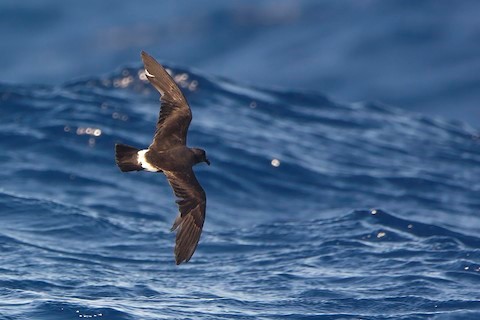
“Madeiran Storm-Petrel”, H. c. castro —likely this subspecies, based on molt-stage, season, and location within its known breeding range—but these factors are also consistent with Monteiro’s, Cape Verde, and first-year “Grant’s”, all plausible alternative identifications. (Offshore northeast of Lanzarote, Canary Islands, Spain; November 1, 2014.) © Miguel Rouco
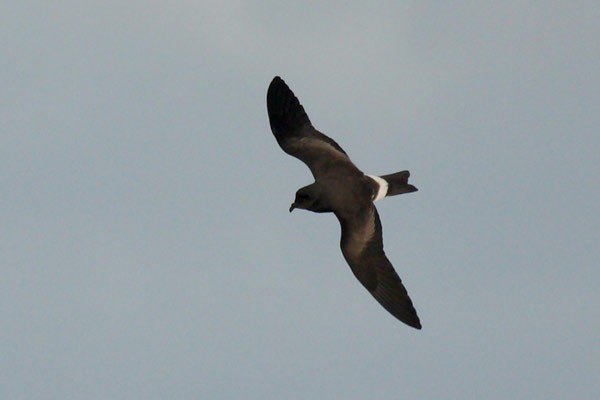
Monteiro’s Storm-Petrel—based on large samples of measured individuals at their Azorean breeding sites, Monteiro’s tends to have a more deeply notched tail than “Grant’s”, but their measurements overlap. (Offshore from Graciosa, Açores, Portugal; May 2011.) © Gareth Knass

“Gulf of Guinea Storm-Petrel”, H. c. ssp. nova, showing apparently thin rump-band and long-looking tail. © William H. Wagstaff
Monteiro’s Storm-Petrel (monteroi): Breeds in the Azores from March to October (eggs laid from early May to early July). Gives the shortest, simplest calls, with a rougher, scratchier quality than the others. Relatively small-bodied, long-tailed, and long-winged, and usually has a visibly notched tail.
“Grant’s Storm-Petrel” (ssp. nova): Breeds from the Azores east to the Berlengas and south to the Canaries from August to April (eggs laid from early October to early December). Calls end with signature punctuation. Relatively large and robust, and has a squarish or shallowly notched tail. Post-breeding adults show heavy feather-wear and/or molting flight feathers most noticeably from April to June—when Monteiro’s and “Madeiran” are fresh-plumaged.
“Madeiran Storm-Petrel” (castro): Breeds in Madeira, the Selvagens, and the Canaries from April to October (eggs laid in June and July). Calls are squeaky, rapid, about intermediate in length between Monteiro’s and Cape Verde, and lack the particular ending of “Grant’s”. Relatively small and slim overall; tail can appear either square-tipped or notched.
Cape Verde Storm-Petrel (jabejabe): Breeds in Cape Verde over an extended season, possibly year-round with two peaks—one from October into winter, the other from April into summer. Gives the longest, most complex calls, and genetic analyses indicate that it is the oldest divergent lineage in the band-rumped complex. Proportions are average, and has a squarish or shallowly notched tail.
“Gulf of Guinea Storm-Petrel” (ssp. nova): Breeds on São Tomé over an extended season, possibly year-round. Calls are relatively long and complex, suggesting an affinity with Cape Verde. Appears slightly larger than other forms, with a narrow white rump band and long-looking squarish or shallowly notched tail.
“St. Helena Storm-Petrel” (helena): Breeds on St. Helena and Ascension in two seasons—possibly multiple distinct forms or cryptic species—one from October to March, the other from April to September. Attends the nest diurnally. On some individuals the white rump band extends far down undertail coverts. Slightly larger than most other forms; usually shows a visibly notched tail.
Additional Photos of “Grant’s Storm-Petrel”
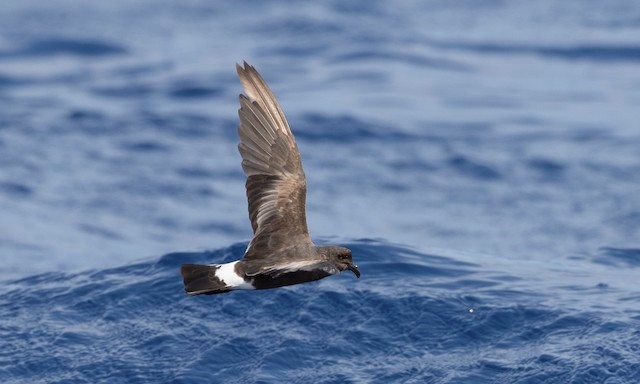
“Grant’s Storm-Petrel”, H. c. ssp. nova. (Offshore from Cape Hatteras, North Carolina; June 8, 2018.) © Brian Sullivan
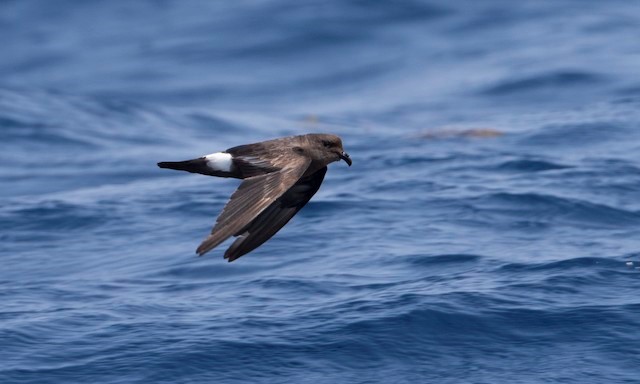
“Grant’s Storm-Petrel”, H. c. ssp. nova. (Offshore from Cape Hatteras, North Carolina; June 7, 2018.) © Brian Sullivan

“Grant’s Storm-Petrel”, H. c. ssp. nova. (Offshore from Cape Hatteras, North Carolina; June 1, 2015.) © Michael Todd
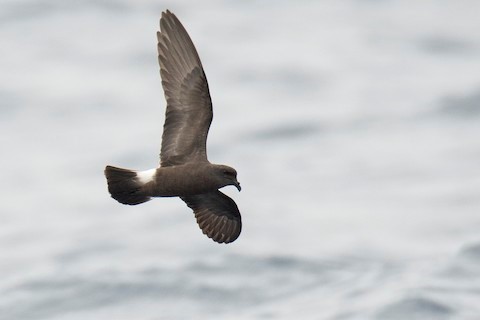
“Grant’s Storm-Petrel”, H. c. ssp. nova. (Banco de la Concepción, Canary Islands, Spain; September 2, 2017.) © Miguel Rouco
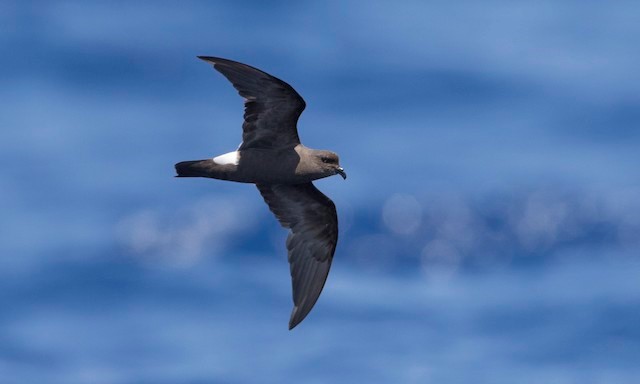
“Grant’s Storm-Petrel”, H. c. ssp. nova. (Offshore from Cape Hatteras, North Carolina; June 8, 2018.) © Brian Sullivan
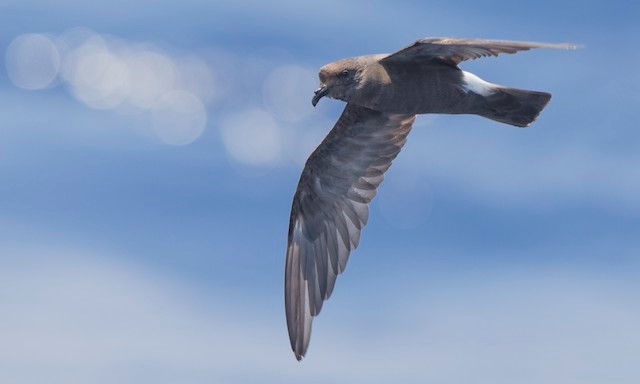
“Grant’s Storm-Petrel”, H. c. ssp. nova. (Offshore from Cape Hatteras, North Carolina; June 8, 2018.) © Steve Kelling
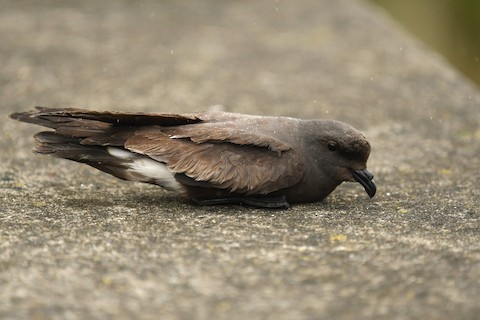
“Grant’s Storm-Petrel”, H. c. ssp. nova. (Baía de Porto Pim, Faial, Azores; December 2, 2021.) © Andre Vieira
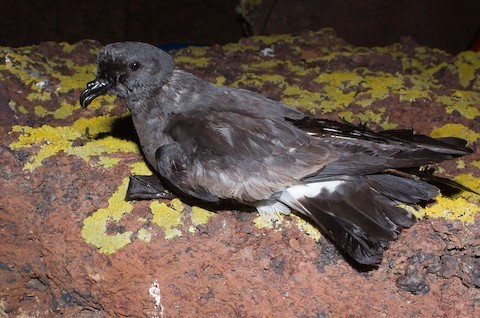
“Grant’s Storm-Petrel”, H. c. ssp. nova. (Isla Montaña Clara, Canary Islands; December 19, 2014.) © Stephen Menzie
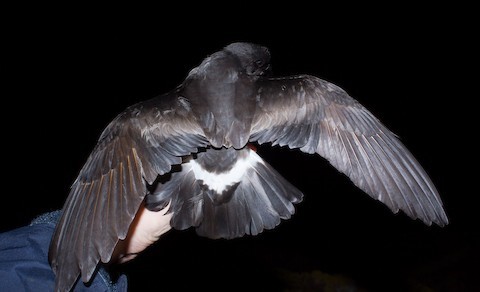
“Grant’s Storm-Petrel”, H. c. ssp. nova, showing a relatively narrow white rump-band. (Isla Montaña Clara, Canary Islands; December 19, 2014.) © Stephen Menzie

“Grant’s Storm-Petrel”, H. c. ssp. nova, showing a relatively broad white rump-band. (Farol do Arnel, São Miguel, Azores; November 4, 2018.) © Alba Villarroya
References
Alderfer, J., and J.L. Dunn. 2014. National Geographic Complete Birds of North America (Second Edition). National Geographic Society, Washington, D.C.
BirdLife International. 2018. Hydrobates castro. The IUCN Red List of Threatened Species 2018: e.T132341128A132433305. https://dx.doi.org/10.2305/IUCN.UK.2018-2.RLTS.T132341128A132433305.en. (Accessed December 29, 2021.)
Bolton, M., A.L. Smith, A. L., E. Gómez-Díaz, V.L. Friesen, R. Medeiros, J. Bried, J.L. Roscales, and R.W. Furness. 2008. Monteiro’s Storm Petrel Oceanodroma monteiroi: a new species from the Azores. Ibis 150:717-727.
eBird. 2021. eBird: An online database of bird distribution and abundance. Cornell Lab of Ornithology, Ithaca, N.Y. http://www.ebird.org. (Accessed December 29, 2021.)
Garcia-del-Rey, E. 2011. Field Guide to the Birds of Macaronesia: Azores, Madeira, Canary Islands, Cape Verde. Lynx Editions, Barcelona.
Garcia-del-Rey, E. 2018. Birds of the Canary Islands. Christopher Helm, London.
Harrison, P. 1983. Seabirds: An Identification Guide. Houghton Mifflin, Boston.
Howell, S.N.G. 2012. Petrels, Albatrosses & Storm-Petrels of North America. Princeton University Press.
Howell, S.N.G., and K. Zufelt. 2019. Oceanic Birds of the World. Princeton University Press.
Kirwan, G.M., A. Levesque, M. Oberle, and C.J. Sharpe. 2019. Birds of the West Indies. Lynx Edicions, Barcelona.
Onley, D., and P. Scofield. 2007. Albatrosses, Petrels & Shearwaters of the World. Princeton University Press.
Raffaele, H., J. Wiley, O. Garrido, A. Keith, and J. Raffaele. 1998. A Guide to the Birds of the West Indies. Princeton University Press.
Sibley, D.A. 2014. The Sibley Guide to Birds (Second Edition). Alfred A. Knopf. New York.
Svensson, L., K. Mullarney, and D. Zetterström. 2009. Birds of Europe (Second Edition). Princeton University Press.
Taylor, R.S., M. Bolton, A. Beard, T. Birt, P. Deane-Coe, A.F. Raine, J. González-Solís, S.C. Lougheed, and V.L. Friesen. 2019. Cryptic species and independent origins of allochronic populations within a seabird species complex (Hydrobates spp.). Molecular Phylogenetics and Evolution 139:106552.
The Sound Approach. 2019. Grant’s Storm-Petrel, Oceanodroma [castro]. https://soundapproach.co.uk/species/grants-storm-petrel/.
Xeno-Canto. 2021. Band-rumped Storm Petrel – Oceanodroma castro. https://xeno-canto.org/species/Oceanodroma-castro. (Accessed December 29, 2021.)
